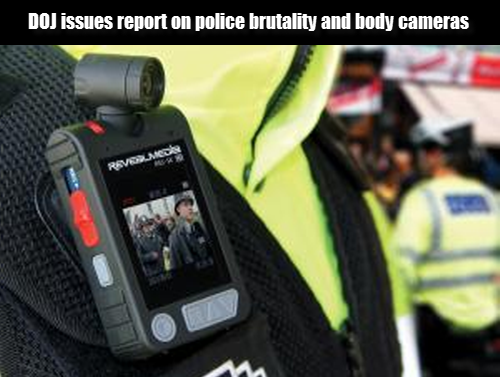
Department of Justice issues report on body cameras and police

The US Department of Justice (DOJ) released a report last Friday detailing its recommendations and possible issues regarding the use of body cameras by police. The report which was authored by the DOJ’s Community Oriented Policing Services office, consisted of a survey of 254 law enforcement agencies and how they implement the technology into everyday encounters with the public. One significant conclusion that the report reached was that there is a correlation between the use of body-worn cameras and the reduction of excessive use of force complaints.
The report reads in part,
The recent emergence of body-worn cameras has already had an impact on policing, and this impact will only increase as more agencies adopt this technology. The decision to implement body-worn cameras should not be entered into lightly. Once an agency goes down the road of deploying body-worn cameras—and once the public comes to expect the availability of video records—it will become increasingly difficult to have second thoughts or to scale back a body-worn camera program.
A police department that deploys body-worn cameras is making a statement that it believes the actions of its officers are a matter of public record. By facing the challenges and expense of purchasing and implementing a body-worn camera system, developing policies, and training its officers in how to use the cameras, a department creates a reasonable expectation that members of the public and the news media will want to review the actions of officers. And with certain limited exceptions that this publication will discuss, body-worn camera video footage should be made available to the public upon request—not only because the videos are public records but also because doing so enables police departments to demonstrate transparency and openness in their interactions with members of the community.
Body-worn cameras can help improve the high-quality public service expected of police officers and promote the perceived legitimacy and sense of procedural justice that communities have about their police departments. Furthermore, departments that are already deploying body-worn cameras tell us that the presence of cameras often improves the performance of officers as well as the conduct of the community members who are recorded. This is an important advance in policing. And when officers or members of the public break the law or behave badly, body-worn cameras can create a public record that allows the entire community to see what really happened.
At the same time, the fact that both the public and the police increasingly feel the need to videotape every interaction can be seen both as a reflection of the times and as an unfortunate commentary on the state of police-community relationships in some jurisdictions. As a profession, policing has come too far in developing and strengthening relationships with its communities to allow encounters with the public to become officious and legalistic. Body-worn cameras can increase accountability, but police agencies also must find a way to preserve the informal and unique relationships between police officers and community members.
This publication, which documents extensive research and analysis by the Police Executive Research Forum (PERF), with support from the U.S. Department of Justice’s Office of Community Oriented Policing Services (COPS Office), will demonstrate why police departments should not deploy bodyworn cameras carelessly. Moreover, departments must anticipate a number of difficult questions— questions with no easy answers because they involve a careful balancing of competing legitimate interests, such as the public’s interest in seeing body-worn camera footage versus the interests of crime victims who would prefer not to have their images disseminated to the world. One of the most significant questions departments will face is how to identify which types of encounters with members of the community officers should record. This decision will have important consequences in terms of privacy, transparency, and police-community relationships. Read more…